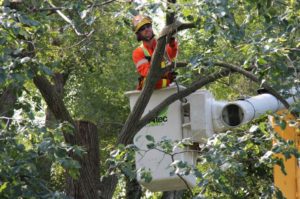Introduction
Everyone loves trees, not only because of the shade it gives us, but also the beauty it brings to the environment and nature at large. Street tree play a major role in the community and requires maintenance every now and then. In Denver, Colorado, property owners are mainly the people responsible for taking care of the street trees. But in real sense they(the trees) are owned by the Denver residents.
To enable proper maintenance of the trees the government has place rules and regulations to be followed while pruning,planting or removal to meet the required ISA standards. On the other hand, if you have private trees such as those in your backyard, you will have fewer regulations to adhere to. In this article we will look at Guidelines for street tree maintenance, regulations and laws in Denver, Colorado.
Here are the top 5 guidelines you need to know for tree maintenance in Denver
- Permit is Key

Tree Service pruning a street tree in Denver, CO
Always get a permit if you are planning to plant/remove a tree near your home or to trim it. This is to avoid trees being cut off with no reason leading to destruction of trees. The permit is usually free of charge hence you not incur extra cost while getting it. The guidelines for pruning a right of way tree are usually the same as that of the licensed tree service, who can also be hired to maintain the trees if need be.
- Trees as a Structural Hazard
Some of the trees may be harmful to you and the surrounding hence it is your responsibility to identify them and have them brought down. If you encounter a dispute with your neighbor about any street tree, the matter can be settled in a civil manner or through an intervention from the city arborist. In most cases this happens if the tree is an imminent structural hazard.
- The Legal Pruning Cut
Legally the pruning cut must be on the outside branch-collar in the following order: first there is an undercut which is about two feet apart, the second cut at the top is a bit further out from the branch collar, while the final cut is done at the front of the branch collar removing the other two foot stub. It is crucial to note that the saws used for pruning are often sharp hence no one should sit under it during the process.
- Planting Trees in the Right of Way
The evergreen types of trees are not allowed when planting trees in the right of way, as they cover or block the site lines. However, there are other types of trees allowed for shade such as the Kentucky Coffee tree, English Oak, Hack-berry, Texas Red Oak, Bur Oak, Catalpa, Chinkapin Oak, Japanese Pagoda tree, Sycamore and the Yellow-wood tree.
- Tree Spacing While Planting
If you are planting a street trees you are required to space the as follows; the ornamental-trees should be about twenty five feet apart and the shade-tree to be approximately thirty five feet apart. All other trees should be about twenty feet from the street light, ten feet from the drive-ways, alleys or seven feet from sidewalks.
Conclusion
Trees play an important role in our environment and should not be overlooked. The rules and regulations place protecting the street trees during planting, pruning, remodeling your home, or landscaping should be followed. Above all do not attempt to take down or remove large trees on your own, it is a very dangerous job that needs to be handled by an insured tree company.
Damages to these trees may lead to you receiving an administration citation or a fine by the City Forester’s office. All this can be avoided if you follow the above pointers. For more information about the regulations and guidelines contact Denver Forestry or visit their website.